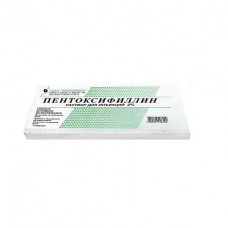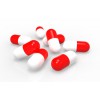Expiration date: 04/2026
pharmachologic effect
Pentoxifylline - a means of improving microcirculation, angioprotector derivative theobromine. Pentoxifylline reduces blood viscosity causes platelet disaggregation, increases the elasticity of red blood cells (due to the impact on pathologically altered deformability of red blood cells), improves microcirculation and increases the concentration of oxygen in the tissues. Increasing the concentration of cAMP in platelets and ATP in erythrocytes with simultaneous saturation of the energy potential, which in turn leads to vasodilation, decreased systemic vascular resistance, increase in stroke volume and cardiac output without significant change in heart rate.
Expanding the coronary arteries, increases the delivery of oxygen to the myocardium, expanding lung vessels, improves blood oxygenation. It improves the tone of respiratory muscles (intercostal muscles and the diaphragm).
In / in the introduction, in addition to the above effect, leads to increased collateral circulation, increase the volume of blood flowing through a unit cross section.
It increases the concentration of ATP in the brain, a positive effect on the bioelectric activity of the CNS. It improves the microcirculation in the areas of impaired circulation.
In peripheral arterial occlusive disease ( "intermittent" claudication) leads to a lengthening of the distance away, elimination of night leg cramps and pain at rest.
Pharmacokinetics
After oral administration, it is well absorbed from the gastrointestinal tract. There negligible metabolism in the "first pass" through the liver. Associated with the membranes of red blood cells. Biotransformation first in erythrocytes, followed by the liver. Some are active metabolites. T1 / 2 of plasma unchanged substance is 0.4-0.8 hours, metabolites -. 1-1.6 hours after 24 hours most of the dose is excreted in the urine as metabolites, a minority (about 4%) - through the intestines.
Elimination of pentoxifylline reduced in elderly patients and in liver disease.
testimony
Peripheral circulatory disorders (including with intermittent claudication) associated with chronic occlusive disorders of blood circulation in the arterial vessels of the lower extremities.
Ischemic cerebrovascular disease, ischemic stroke and post stroke state; cerebral atherosclerosis (dizziness, headache, memory impairment, sleep disorders), encephalopathy, viral neuroinfection (prevention of possible violations of the microcirculation).
Coronary artery disease, condition after myocardial infarction.
Diabetic angiopathy.
Acute disorders of blood circulation in the retina and choroid, acute ischemic optic neuropathy.
Otosclerosis, degenerative changes in the background pathology of vessels of the inner ear, with a gradual decrease in hearing. COPD, asthma.
Impotence of vascular origin.
Contraindications
Acute myocardial infarction, porphyria, massive bleeding, hemorrhagic stroke, retinal hemorrhage, pregnancy, lactation. For in / in the introduction (optional) - arrhythmia, marked atherosclerosis of the coronary or cerebral arteries, uncontrolled hypotension.
Hypersensitivity to pentoxifylline or other xanthine derivatives.
special instructions
C wary of labile blood pressure (tendency to hypotension), chronic heart failure, stomach ulcers and duodenal ulcers (oral), after recently transferred surgical intervention, with liver and / or kidney failure in children and adolescents under the age of 18 years (effectiveness and safety have not been studied).
If renal impairment or severe hepatic dysfunction require correction mode pentoxifylline.
In the period of treatment should control the level of blood pressure.
In an application with antihypertensive agents, insulin, oral hypoglycemic agents may be required to reduce the dose of pentoxifylline.
In an application with anticoagulants should be carefully monitored blood coagulation indicators.
Composition
1 ml contains:
Active ingredient: 20 mg of pentoxifylline;
Excipients: sodium chloride, water for injections.
Dosing and Administration
Apply intraarterially (bolus or infusion), intravenous (bolus or infusion), intramuscularly. The dose and treatment regimen set individually.
Side effects
CNS: headache, dizziness; anxiety, sleep disorders; convulsions.
Dermatological reactions: flushing of the face, "tides" of blood to the skin of the face and upper chest, swelling, increased fragility of nails.
From the digestive system: dry mouth, decreased appetite, intestinal atony, aggravation cholecystitis, cholestatic hepatitis, increased activity of hepatic transaminases and alkaline phosphatase.
On the part of the organ of vision: blurred vision, scotoma.
Cardio-vascular system: tachycardia, arrhythmia, false angina, the progression of angina, lower blood pressure.
From hemopoiesis system: thrombocytopenia, leukopenia, pancytopenia.
From the blood coagulation system: gipofibrinogenemia; bleeding from the vessels of the skin, mucous membranes, stomach, intestines.
Allergic reactions: itching, skin flushing, urticaria, angioedema, anaphylactic shock.
Drug interactions
Pentoxifylline may potentiate the action of antihypertensive drugs.
Against the background of parenteral use of pentoxifylline in high doses may increase the hypoglycemic effect of insulin in patients with diabetes mellitus.
In an application with ketorolac may increase the risk of bleeding and / or increased prothrombin time; with meloxicam - the increased risk of bleeding; with sympatholytic, vasodilators and ganglioblokatorami - possible decrease in blood pressure; sgeparinom, fibrinolytic drugs - increased anticoagulant action.
Cimetidine significantly increases the concentration in plasma pentoxifylline, therefore, while the application may increase the likelihood of side effects.


